Top 10 Iran Deserts

When thinking of Iran, many travelers have in mind images of vast deserts and golden sand dunes. While Iran has much more than deserts, with snowy mountains and green forests, it’s true that it is also a great destination for an expedition in the sand dunes. The desert indeed covers one-third of the country, with two major deserts, and many smaller ones. Ready to explore these exceptional landscapes? In this article, we’ll introduce you to the 10 best deserts in Iran for an unforgettable journey.
Contents
Iran’s Deserts Overview
More than half of the country is made of dry and semi-arid deserts in Iran. That’s why you can find deserts, whether they’re small or big, in 18 different regions. These deserts can have different aspects: they can be the ideal landscapes of sand dunes such as what you can experience in Maranjab, or instead being made of huge rock formations, like the beautiful Kaluts that reminds of the USA’s Monument Valley.
There are in Iran two main deserts. The first one, and the largest, is Dasht-e Kavir. It spreads in the central part of the country, and contains most of the famous desert destinations. The other one is Dasht-e Lut that is located in the southeast and is known as one of the hottest places on earth, with some areas completely devoid of any living creatures, including bacteria.
1. Dasht-e Kavir
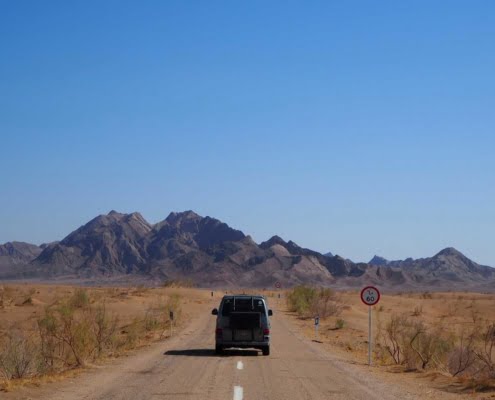
Also known as the Great Salt Desert, Dasht-e Kavir is the largest desert in Iran, with an area of 77.600 square kilometers. It’s located on the Iranian central plateau, in the southeast part of the Alborz mountains. The Dasht-e Kavir is famous for its salt flats, sand dunes and salt marshes. Wild sheep, camels, and gazelle are living in the area.
This desert experiences large temperature variations. In summer, the temperature can reach 60 degrees Celsius at mid-day and fall to 30-25 at night. Likewise, during winter, the desert can be pretty cold: during the day, the temperature rises to 17 but falls down to -7 at night!
The desert has many interesting sightseeing such as Kavir National Park, Sefidab and Eyn-o Rashid caravanserai, Hoz Ghilooghe and Hoz Soltan, Sirjan Salt Swamp and Ghaleh Sefi-Ab. But the most visited is the Salt Lake (Daryache Namak) that covers a surface of 1800 square kilometers.
2. Dasht-e Lut
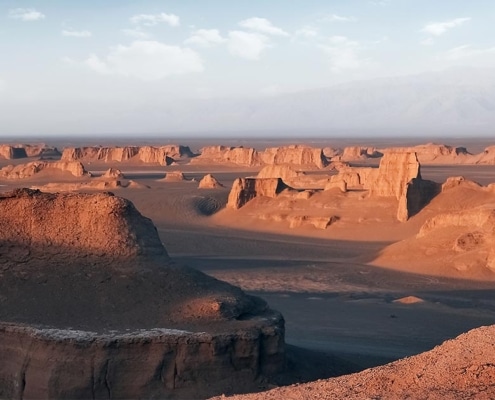
Dasht-e Lut is the second main desert in Iran and probably the most famous. Located in the southeast part of the country, on the provinces of Kerman, South Khorassan and Sisan Baluchistan, it has been inscribed as a World Heritage Site by UNESCO in 2016. Indeed, Lut Desert is a natural gem that contains traces of human life dating back to the 3rd and 4th millennium BC. It’s also famous for its rock formations, called yardlang, creating extraordinary landscapes.
Yet, this desert, which is the world’s 25th largest (it covers an area of 51.800 square kilometers), is pretty unhospitable. It’s where some of the highest surface temperatures on earth have been recorded, reaching 70.7 degrees Celsius.
3. Shahdad Desert
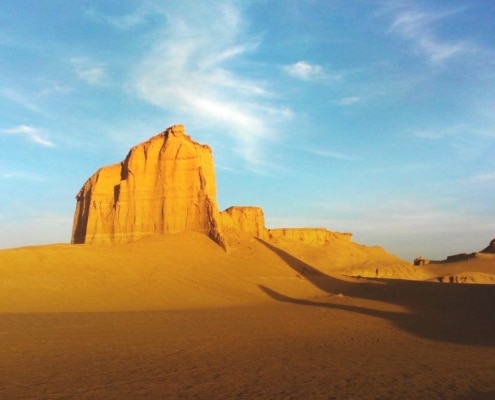
Shahdad Desert is located at the heart of Dash-e Lut, about 100 kilometers away from Kerman. It is generally the favorite destination for those who intend to see the great rock formations of the Lut Desert, the Kaluts. The Kaluts were shaped about 20.000 years ago by the process of wind and water erosion. They create a breathtaking landscape that many consider as one of the most beautiful deserts in the world.
There may also have been an ancient city in Shahdad, as bronze and clay objects have been discovered there. In addition, there are also water reservoirs, qanat and historical castles to visit in the area.
4. Maranjab Desert
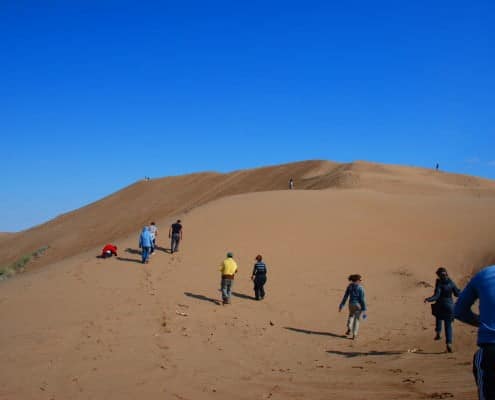
Located near the historical city of Kashan, close to the town of Aran o Bigdol, the Maranjab Desert is one of the most popular desert destinations in Iran. The majority of this desert is covered with vast sand dunes providing an amazing playground for camel riding, off-road, or sandboarding. The Maranjab Desert also has rich vegetation and wildlife, with foxes, sand cats, lizards, eagles…
As part of the Dasht-e Kavir, one of Maranjab Desert’s highlights is the previously mentioned Salt Lake. Used for salt extraction, the lake can be visited, but would rather be done with a professional guide as the surrounding lands are swamps. Other sightseeing in the Maranjab Desert include the Maranjab Caravanserai, dating back to the 17th century. This desert was indeed part of the historical Silk Road and this caravanserai would provide a safe place to rest for the merchants’ caravans but also be used as a fortress with more than 500 soldiers stationed there.
5. Mesr Desert
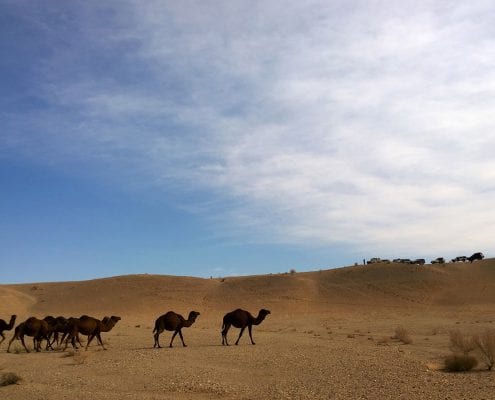
The large Mesr Desert is among the most beautiful deserts of Iran, with its high pristine sand dunes. Located in Isfahan Province, 55 kilometers away from the city of Khur, its remote location helped preserve an untouched nature. One of the particularities of Mesr are the small desert villages of Mesr and Farahzad. At night, you can observe a sky full of stars sitting on the roof of Mesr’s old houses. While in Farahzad, you can enjoy the green scenery of date palm tree gardens that make the visitors feel like they are in an oasis.
As one of the main destinations for visiting the desert in Iran, the desert provides many facilities, whether it’s for accommodation or tours and outdoor activities such as camel riding, safari, and trekking in the dunes.
6. Varzaneh Desert
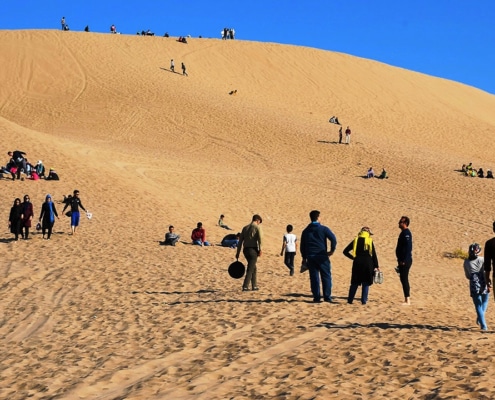
Varzaneh Desert, located in Isfahan Province, is another desert which is part of the large Dasht-e Kavir. Situated between the cities of Isfahan and Yazd, it’s famous for its sand dunes that can reach up to 100 meters. Many visitors choose to camp in Varzaneh Desert to appreciate the silence of the desert at night.
There are also many sightseeing nearby Varzaneh Desert, including the old abandoned village of Kharanaq, the Pigeon Towers, the Anahita Temple, the Ghoortan Citadel, the Gavkhooni Vetland, the Mirmiran House, and the Friday Mosque of Varzaneh.
7. Rig-e Zarin
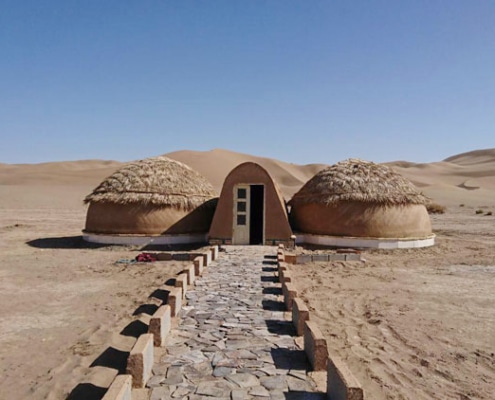
Rig-e Zarin, also known as Mughistan, is a sand dunes desert located north of Yazd and that is part of the Dasht-e Lut. It covers an area of about 27.000 square kilometers. This desert has high sand dunes that can reach up to 150 meters and sparse vegetation and wildlife. Despite harsh living conditions, a few nomadic tribes inhabit this area. At the center of the desert is located a 2050 meters’ black mountain, which gave the desert its nickname of “Black Desert”.
8. Halvan Desert
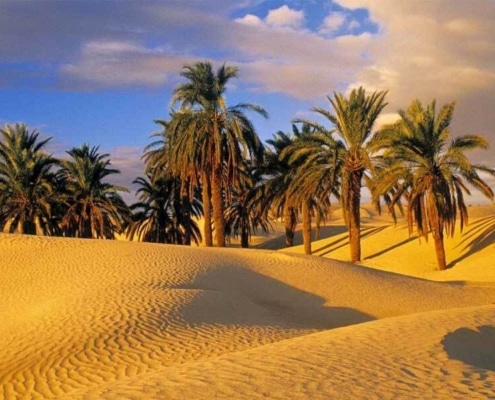
Located in the area of the newly UNESCO geopark of Tabas, in western Iran, Halvan Desert is famous for holding magnificent date palm tree gardens. At the heart of this desert is the village of Halvan, which has a singular eye-catching architecture and a beautiful castle that once had 13 towers. In the area also is a salt marshland and the Salt Khor Lake.
9. Rig-e Jenn
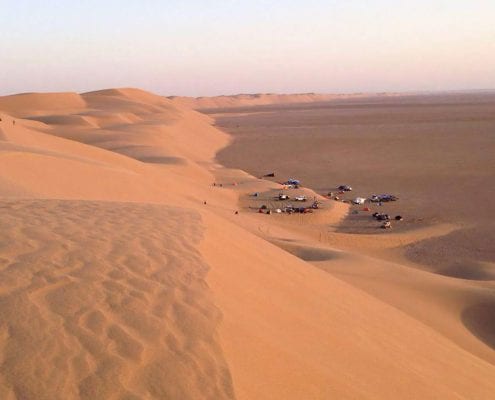
Also sometimes called the Bermuda Triangle of Iran, Rig-e Jeen means “the desert of Jinn”. In Islam, jinn are invisible spirits that can either be evil or good and that inhabit the earth under various forms. Many people in Iran firmly believe in their existence and often fear them.
Rig-e Jeen may have been named this way as it’s devoid of any living creatures. Part of the large Dasht-e Kavir, it has a vast expanse of sand and salt plains, strange rock formations (yardangs), and several swamps that can be dangerous. For all these reasons, this desert has always been avoided by ancient travellers and there is still no road or villages in this area, leaving the area untouched and mysterious.
10. Darak Desert
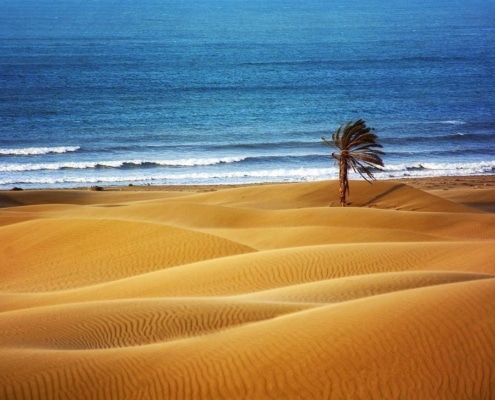
Darak Desert, located in the region of Sistan and Baluchistan, by the coast of the Gulf of Oman, is one of the rare deserts in the world that meets the sea. While it’s a small area revolving around the village of Darak, it has among the most spectacular landscapes, with golden sand dunes diving into the turquoise waters of the sea. Still considered an off-the-beaten-path destination, a bit difficult to access (it’s located 150 kilometers west of Chahbahar), it has remained an unspoiled gem.


